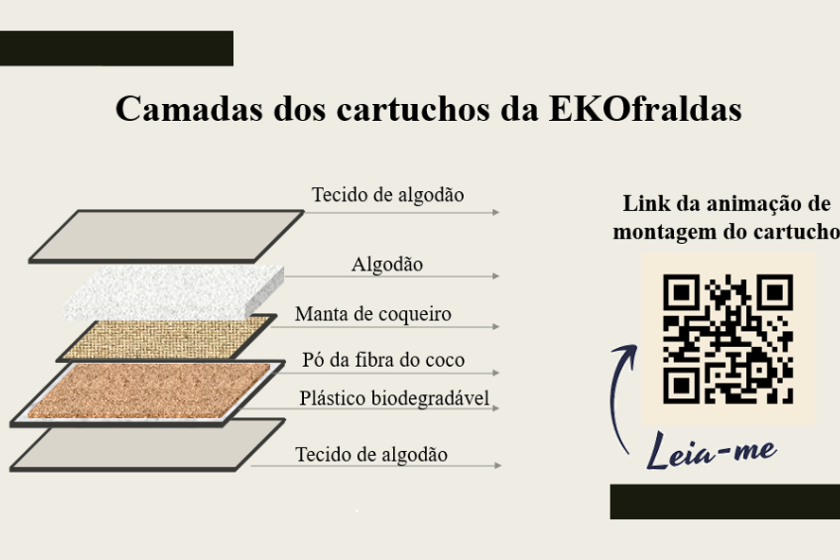Despite the facility of use, disposable diapers have environmental and financial impacts. With frequent use, buying diapers takes a toll on the budget. Furthermore, they can remain in the environment for up to 450 years after disposal. To improve this situation, a group of five students from the Brazilian semi-arid region (known as “sertão nordestino”) developed reusable diapers using a common material locally: coconut shell fibers that would otherwise be discarded by industries. The project was among the 10 finalists of the Solve for Tomorrow program in 2023, in Brazil.
Chemistry teacher Gustavo Bezerra, mediator of the “EKOfraldas” project at the Paulo Freire State Technical School, in the municipality of Carnaíba, in the backlands of Pernambuco, remembers that the idea arose in an elective course called “STEM in practice”, with 28 students from the 2nd year of High School (second to last year of compulsory schooling). At the institution, regular education is offered along with full-time technical courses in computer networks or administration. “There were many young people interested in developing scientific projects, but they were not aware of the methodological basis required for fairs and programs like Solve for Tomorrow. So, in this discipline, we saw a bit about the research method, how these approaches are covered in different programs”, he reports.
The class was divided into groups of 3 to 5 students, and each of them worked on different projects. The “EKOfraldas” were the result of research and experimentation by a group of five students. They had as starting point the Sustainable Development Goals (SDGs), which are 17 ambitious and interconnected plans proposed by the United Nations, to end poverty and to protect the environment and climate, among other actions.
Provoked by discussions in the classroom, the students observed that spending on disposable diapers weighed on their own familie’s budgets and in addition, harmed the environment. Therefore, they thought that a way to solve both problems would be to create a more affordable ecological diaper, as those available on the market were beyond the reach of the majority of the population. “The students found a kit of eight ecological diapers online for R$330 (approximately 64 US dollars). A low-income family here in the interior of Pernambuco state, no matter how much they wanted, would not be able to buy it”, reports the teacher.
I believe that the project changed the lives of the students a lot. Many surprised us, because normally, they weren’t very committed in the classroom. But, when they got involved in the projects, they started to dedicate themselves so much that they became straight-A students in that aspect, in terms of research and laboratory techniques”, says the teacher.

Coconut shell and cotton fabrics take part of the sustainable solution
The initial project, due to the pandemic context, was to reuse fabrics from used masks. But throughout the experiments, the students discovered that these products also have a long decomposition time. So, they started looking for other absorbent materials, until they came up with a combination of cotton fabrics and coconut shells.
The EKOfraldas prototype consists of reusable elastic fabric pants, accompanied by adsorbent cartridges, which must be changed after use. These cartridges are made from an outer layer of biodegradable plastic, which prevents liquids and odors from leaking. Inside, there is cotton combined with coconut fiber, which is capable of absorbing liquids up to 25 times its initial volume. To avoid direct contact of the fibers with the baby’s skin, the cartridge is finished with another layer of fabric. “ For the next stage, we intend to carry out more elaborate allergy and physiological tests, which are essential before testing on people ”, adds the educator.
According to the student´s calculations, the reusable diaper costs 1 BRL (about 0,18 USD) and each biodegradable cartridge would cost 40% of this amount. “To develop the prototype, part of the cost came from the school; other, from the teacher and some materials, such as cotton, were obtained by the students with their parent’s collaboration. On top of that, they did a financial study. Of course, if the diapers were produced on a commercial scale, other expenses would have to be added, such as labor. Even so, they would not be as high and exorbitant as on the market”, highlights the mediator of the project.
I believe that the project changed the lives of the students a lot. Many surprised us, because normally, they weren’t very committed in the classroom. But, when they got involved in the projects, they started to dedicate themselves so much that they became straight-A students in that aspect, in terms of research and laboratory techniques”, says the teacher.
From an experiment to a scientific career
The prototype was successfully tested on dolls. Even in the year of studies for the entrance exam, the team has already started the patent process and intends to continue working on product development. With the visibility given by Solve for Tomorrow, the school has already received contacts from private companies and research institutions, such as the Federal Institute of Pará (IFPA), which offered the structure of their laboratories to continue testing sustainable diapers.
But, in addition to the results of the prototype, project-based learning also enabled new perspectives for young people in the region, who see in science the opportunity to contribute to their communities, visit new places and think about career possibilities that they were not aware of before. The experience of the students who developed the diapers became a reference for other students and for the population of the semi-arid region of Pernambuco.
According to the teacher, the mentoring offered by Solve for Tomorrow showed research paths, gave advice and contributed to showing answers to difficulties that appeared on the scientific path. “Mentoring really comes with ideas of what students can do. Their role in our research was essential. Now, other teachers and teams at the school also want to join the program,” he says.




